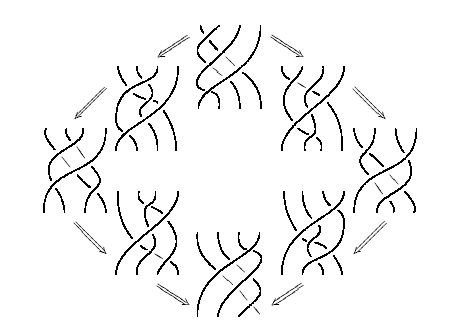Something which bothers me about Lurie’s formulation of the Cobordism Hypothesis, which is also the one which David Ben-Zvi employs, is that he really combines the Extended TQFT Hypothesis and the Cobordism Hypothesis into one.
I think it’s best to keep them separate. Do you agree John (or Jim)? I’m taking my cue from you here, both on these recent slides as well as on previous comments on the café I’ve read of yours.
Let’s have a discussion about this!
To a certain degree, John and Jim are to blame on this, because they originally gave these hypotheses awkward names, calling them the Extended TQFT Hypotheses I and II:
Extended TQFT Hypothesis, Part I. The -category of which -dimensional extended TQFTs are representations is the free stable weak -category with duals on one object.
Extended TQFT Hypothesis, Part II. An -dimensional unitary extended TQFT is a weak -functor, preserving all levels of duality, from the free stable weak -category with duals on one object to Hilb.
The way I would like these hypotheses to be renamed, taking my cue from what John has written, is as follows:
Cobordism Hypothesis. The -category of cobordisms Cob is the free stable weak -category with duals on one object.
Extended TQFT Hypothesis. An -dimensional unitary extended TQFT is a weak -functor, preserving all levels of duality, from the -category of cobordisms Cob to Hilb, the -category of -Hilbert spaces.
Here is my reasoning (if John or Jim disagree, I stand corrected!). We should disentangle the Cobordism Hypothesis from any concept having to do with “TQFT”. It should be viewed simply as a statement about manifolds, namely that “n-categories with duals are the perfect language to describe manifolds and their cobordisms”.
The Extended TQFT Hypothesis (as I wrote it above) should be regarded as hypothesis about what an “extended TQFT” really is, in a mathematical sense. I think this underscores an important point about TQFT, which I have noticed sort of makes a dividing line between two views about what a TQFT is, in a sense.
In the one camp, are those that believe that an extended TQFT is a pre-existing gismo, coming from physics and path integrals and sigma-models and quantum gravity etc., and our task is to describe it mathematically. So when we say “An extended TQFT is…”, it’s not so much of a definition of a concept which was not defined beforehand, but rather an attempt to formalize that concept.
I think there might be another camp, where the definition “An extended TQFT is…” is taken basically at face value, and that concept is not regarded as having any apriori meaning (eg. from physics). In that camp, the Extended TQFT Hypothesis as I have outlined it above is in a sense meaningless… it would be thought of as a definition.
I am in the first camp, and the reason is it is a huge thing to claim that this “idea” of an extended TQFT, which basically means “a topological quantum field theory which satisfies the best possible locality properites”, can be formalized in terms of this weird mumbo-jumbo about higher categories and so on. Many physicists certainly are not convinced of that notion (I’ve heard Witten scoffs at it, for example!). So it should be viewed as a genuine hypothesis. The only way we could prove it would be to show that it is useful to think of extended TQFT’s in that way.
If we combine the Cobordism Hypothesis and the Extended TQFT Hypothesis above together, we get something which I like to call “the primacy of the point”… and this is (almost) the thing which Lurie calls “The Cobordism Hypothesis”:
The ‘primacy of the point’. An -dimensional unitary extended TQFT is completely described by the -Hilbert space it assigns to a point.
I say “almost” above because the feature I loved the most about the original Baez-Dolan version was that word “unitary”, and hence also the idea of an “-Hilbert space”. Lurie’s version doesn’t seem to pay as much homage to these concepts as I would like, which bothers me, but I guess I must just read harder, which I am.
The Cobordism Hypothesis. (Lurie). Let be a stable -category. Then there is a bijection between equivalence classes of stable -functors
(1)
and equivalence classes of fully dualizable objects .
Anyhow, let’s discuss this thing.


Re: Categorification and Topology
Grothendieck wrote to Larry Breen in 1975 about n-types and n-groupoids. See here for a scan of one of the letters concerning this. It is certainly true that in the opening pages of pursuing stacks the homotopy hypothesis is made explicit, but the idea goes back much further.